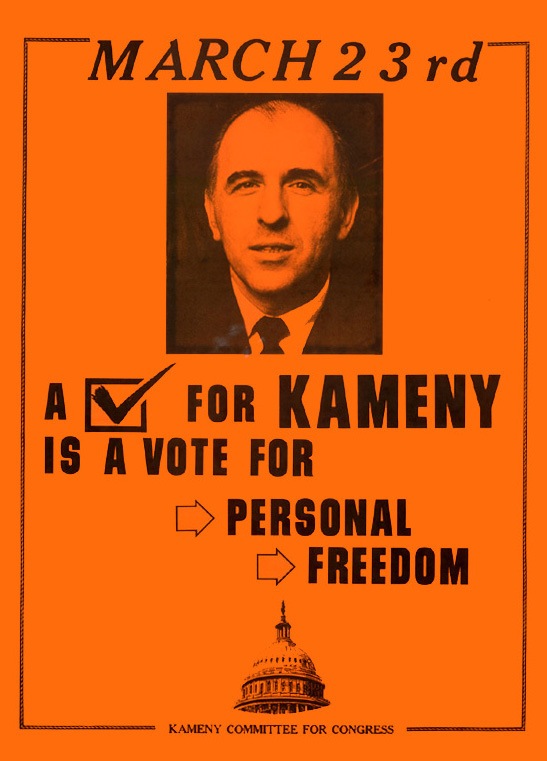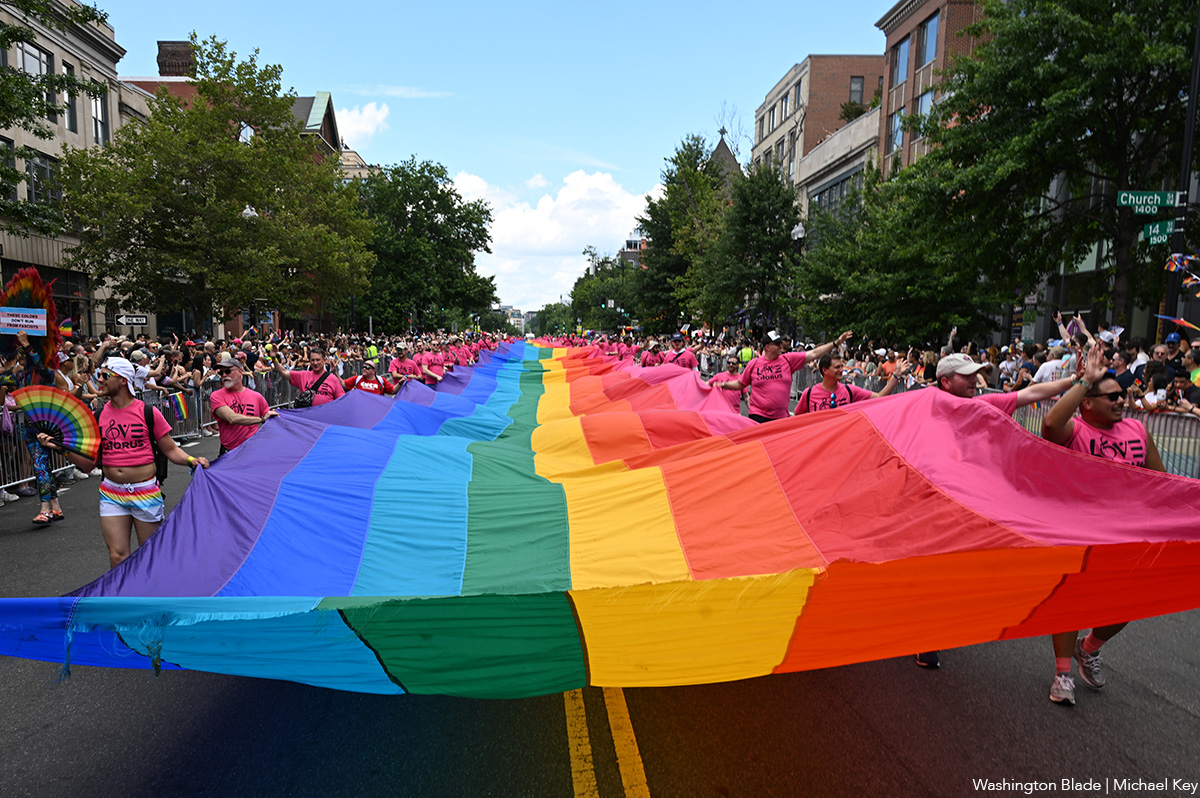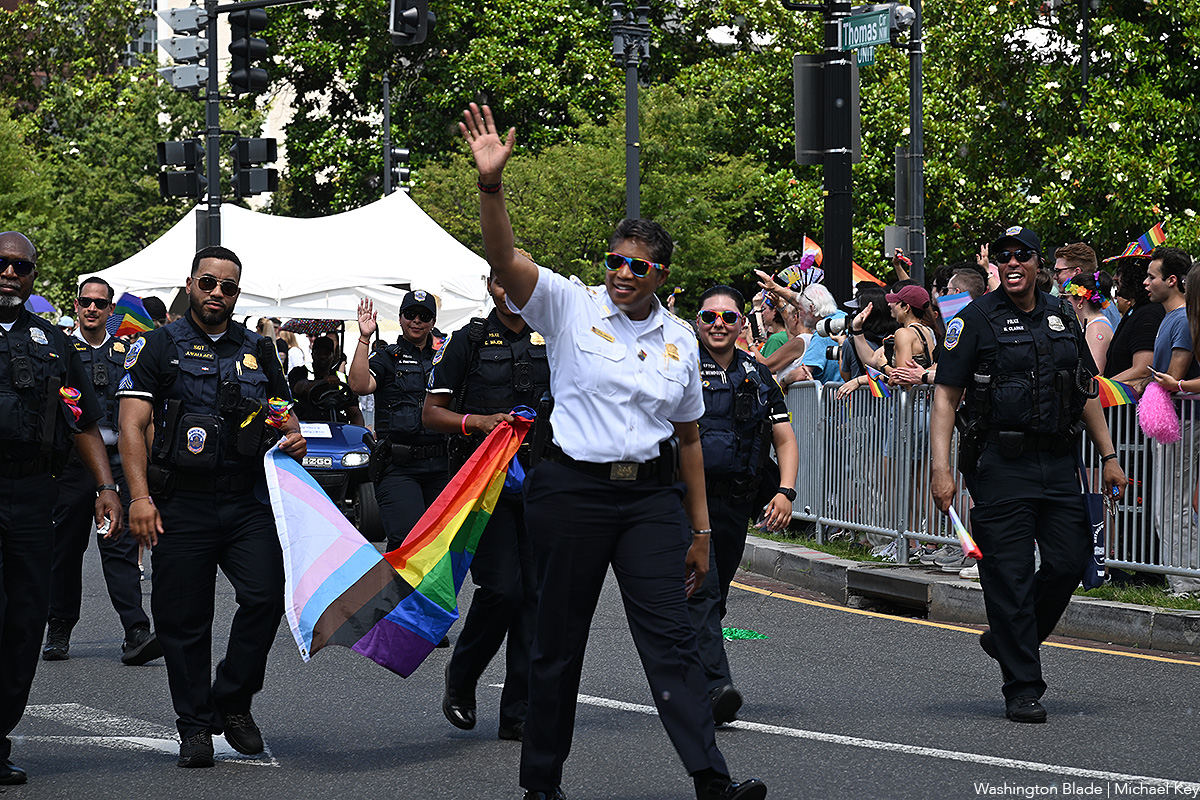Local
The scientific activist
Harvard award draws attention to Frank Kameny’s pre-activist days

Veteran gay rights leader Frank Kameny, who is credited with founding the gay activist movement in Washington 41 years ago, returned to Cambridge, Mass., last month to receive an award from the Harvard University Gay & Lesbian Caucus. Kameny, 77, received a master’s degree from Harvard in 1949 and his Ph.D. there in 1956 — both in the field of astronomy.
With Harvard University President Lawrence Summers looking on, about 200 Harvard gay students and gay alumni gave Kameny a standing ovation on June 6 as an official with the Gay & Lesbian Caucus introduced Kameny at a ceremony on the Harvard campus.
The award presented to Kameny at the ceremony honors him for “his longstanding advocacy and activism and his incredible personal commitment and contribution to the lives of all gay, lesbian, bisexual, and transgender people.”
In an interview this week, Kameny said his return to Harvard brought back memories of his pre-gay activist days — including his studies at Harvard, his early ambitions to become an astronomer and become involved in the U.S. space program, and his service in the military during World War II.
Kameny rarely talks about his pre-activist days in his public appearances on behalf of gay rights. His friends and colleagues in the gay rights movement say those early years played a key role in shaping what observers say has been Kameny’s groundbreaking work on behalf of gays in D.C. and throughout the nation.
Long-time activists know Kameny for his role as founder in 1961 of the Mattachine Society of Washington, D.C., the first gay rights group in the nation’s capital. Shortly after its founding, Kameny broke new ground by leading the first ever gay rights protests in front of the White House, Pentagon and State Department.
Those who know Kameny say few people are aware of his use of the scientific principles and knowledge he acquired in the study of physics and astronomy to debunk the psychiatric theories of the 1950s and 1960s, which held that homosexuality was an illness and that gays suffered from a psychiatric disorder.
In his 1981 book, “Homosexuality and American Psychiatry: The Politics of Diagnosis,” researcher Ronald Bayer credits Kameny with almost single-handedly persuading the early homophile movement to change its position of accepting the prevailing psychiatric theories that gays were disordered to the posture that these theories were scientifically unsound and must be refuted.
Kameny said his love for science began in his teenage years in New York City’s borough of Queens. He graduated from Richmond Hill High School in 1941, at the age of 16, after skipping two grades, in part, because of his exceptional aptitude for science and math. In September 1941, Kameny began his undergraduate studies in physics at New York’s Queens College.
He said he had expected to immerse himself “in the sheer joy” of courses in math and physics, along with other college related activities. But all of that changed abruptly three months later when the Japanese attacked Pearl Harbor. “Nothing was the same after that,” Kameny said.
Two years later, in May 1943, Kameny enlisted in the Army, signing his enlistment papers three days before his 18th birthday. In September of that year, he was called into active duty, where he remained until March 1946. Although he had two years of college under his belt, Kameny said his Army superiors assigned him to a mortar crew with the 58th Armored Infantry, which was part of the Army’s 8th Armored Division in Europe.
Before he knew it, Kameny said, he was engaged in front-line combat in France, Holland and Germany. Some of his most harrowing moments, he said, came during the Battle of the Bulge, where the German army made a ferocious effort to break through the lines of allied forces. Stationed in trenches during freezing whether, Kameny recounts how he and his fellow soldiers endured German artillery fire while trying to catch some sleep in the dead of night.
“I came within a hair’s breadth of losing my life several times,” Kameny said. “If you hear the whistle of a shell and then the explosion, you’re OK,” he said. “But if the whistle stops suddenly, before the explosion, you’re in gave danger of being hit.”
Years later, Kameny would wear the combat medal he earned in the Battle of the Bulge as he led the D.C. Gay & Lesbian Activists Alliance in presenting its annual Memorial Day wreath at the Tomb of the Unknown Soldier at Arlington National Cemetery.
Space ambitions jettisoned
At the conclusion of the war, Kameny returned to Queens College after being discharged from the Army in 1946. He completed his undergraduate work less than two years later and began his studies at Harvard. While there, he taught astronomy at Yale University and later traveled to Arizona and Northern Island, where he conducted research in astronomy at internationally acclaimed observatories. After receiving his PhD. at Harvard in 1956, he began teaching astronomy at Georgetown University.
In 1957, he left Georgetown after being recruited by the government to take a job as an astronomer with the Army Map Service in Washington. The nation’s race against the Russians for superiority in space had just begun in full force. Kameny had set his sights, among other things, on a possible role in the U.S. space program. A short time later, Congress created the National Aeronautics & Space Administration. Kameny has said he would have seriously considered applying to become an astronaut. But that was not to come about.
Just five months into his job at the Army Map Service, U.S. government security officials discovered Kameny was gay and opened an investigation into Kameny’s alleged “threat” to national security. Within a few weeks, he was dismissed from his job, with his name placed on a list of people labeled as government security risks.
Kameny fought his dismissal in court, taking it all the way to the U.S. Supreme Court, where he became the first to challenge a firing by the federal government on grounds of sexual orientation. The high court let stand a lower court ruling against Kameny, effectively ending his career as a civil servant and an astronomer.
What Kameny did next, as the saying goes, is part of history — at least the history of the U.S. gay civil rights movement. His longtime friend and fellow activist, Craig Howell, has said that had it not been for the government’s discovery of his sexual orientation, Kameny would likely have become one of the world’s eminent astronomers.
“The government’s loss became our gain,” said Howell.

District of Columbia
Capital Pride announces change in date for 2026 D.C. Pride parade and festival
Events related to U.S. 250th anniversary and Trump birthday cited as reasons for change

The Capital Pride Alliance, the D.C. based group that organizes the city’s annual LGBTQ Pride events, has announced it is changing the dates for the 2026 Capital Pride Parade and Festival from the second weekend in June to the third weekend.
“For over a decade, Capital Pride has taken place during the second weekend in June, but in 2026, we are shifting our dates in response to the city’s capacity due to major events and preparations for the 250th anniversary of the United States,” according to a Dec. 9 statement released by Capital Pride Alliance.
The statement says the parade will take place on Saturday, June 20, 2026, with the festival and related concert taking place on June 21.
“This change ensures our community can gather safely and without unnecessary barriers,” the statement says. “By moving the celebration, we are protecting our space and preserving Pride as a powerful act of visibility, solidarity, and resistance,” it says.
Ryan Bos, the Capital Pride Alliance CEO and President, told the Washington Blade the change in dates came after the group conferred with D.C. government officials regarding plans for a number of events in the city on the second weekend in June. Among them, he noted, is a planned White House celebration of President Donald Trump’s 80th birthday and other events related to the U.S. 250th anniversary, which are expected to take place from early June through Independence Day on July 4.
The White House has announced plans for a large June 14, 2026 celebration on the White House south lawn of Trump’s 80th birthday that will include a large-scale Ultimate Fighting Championship (UFC) event involving boxing and wrestling competition.
Bos said the Capital Pride Parade will take place along the same route it has in the past number of years, starting at 14th and T Streets, N.W. and traveling along 14th Street to Pennsylvania Ave., where it will end. He said the festival set for the following day will also take place at its usual location on Pennsylvania Avenue, N.W., between 2nd Street near the U.S. Capitol, to around 7th Street, N.W.
“Our Pride events thrive because of the passion and support of the community,” Capital Pride Board Chair Anna Jinkerson said in the statement. “In 2026, your involvement is more important than ever,” she said.
District of Columbia
Three women elected leaders of Capital Pride Alliance board
Restructured body includes chair rather than president as top leader

The Capital Pride Alliance, the D.C.-based group that organizes the city’s annual LGBTQ Pride events, announced it has restructured its board of directors and elected for the first time three women to serve as leaders of the board’s Executive Committee.
“Congratulations to our newly elected Executive Officers, making history as Capital Pride Alliance’s first all-women Board leadership,” the group said in a statement.
“As we head into 2026 with a bold new leadership structure, we’re proud to welcome Anna Jinkerson as Board Chair, Kim Baker as Board Treasurer, and Taylor Lianne Chandler as Board Secretary,” the statement says.
In a separate statement released on Nov. 20, Capital Pride Alliance says the restructured Board now includes the top leadership posts of Chair, Treasurer, and Secretary, replacing the previous structure of President and Vice President as the top board leaders.
It says an additional update to the leadership structure includes a change in title for longtime Capital Pride official Ryan Bos from executive director to chief executive officer and president.
According to the statement, June Crenshaw, who served as acting deputy director during the time the group organized WorldPride 2025 in D.C., will now continue in that role as permanent deputy director.
The statement provides background information on the three newly elected women Board leaders.
• Anna Jinkerson (chair), who joined the Capital Pride Alliance board in 2022, previously served as the group’s vice president for operations and acting president. “A seasoned non-profit executive, she currently serves as Assistant to the President and CEO and Chief of Staff at Living Cities, a national member collaborative of leading philanthropic foundations and financial institutions committed to closing income and wealth gaps in the United States and building an economy that works for everyone.”
• Kim Baker (treasurer) is a “biracial Filipino American and queer leader,” a “retired, disabled U.S. Army veteran with more than 20 years of service and extensive experience in finance, security, and risk management.” She has served on the Capital Pride Board since 2018, “bringing a proven track record of steady, principled leadership and unwavering dedication to the LGBTQ+ community.”
• Taylor Lianne Chandler (Secretary) is a former sign language interpreter and crisis management consultant. She “takes office as the first intersex and trans-identifying member of the Executive Committee.” She joined the Capital Pride Board in 2019 and previously served as executive producer from 2016 to 2018.
Bos told the Washington Blade in a Dec. 2 interview that the Capital Pride board currently has 12 members, and is in the process of interviewing additional potential board members.
“In January we will be announcing in another likely press release the full board,” Bos said. “We are finishing the interview process of new board members this month,” he said. “And they will take office to join the board in January.”
Bos said the organization’s rules set a cap of 25 total board members, but the board, which elects its members, has not yet decided how many additional members it will select and a full 25-member board is not required.
The Nov. 20 Capital Pride statement says the new board executive members will succeed the organization’s previous leadership team, which included Ashley Smith, who served as president for eight years before he resigned earlier this year; Anthony Musa, who served for seven years as vice president of board engagement; Natalie Thompson, who served eight years on the executive committee; and Vince Micone, who served for eight years as vice president of operations.
“I am grateful for the leadership, dedication, and commitment shown by our former executive officers — Ashley, Natalie, Anthony, and Vince — who have been instrumental in CPA’s growth and the exceptional success of WorldPride 2025,” Bos said in the statement.
“I look forward to collaborating with Anna in her new role, as well as Kim and Taylor in theirs, as we take on the important work ahead, prepare for Capital Pride 2026, and expand our platform and voice through Pride365,” Bos said.
District of Columbia
D.C. Police Chief Pamela Smith to step down Dec. 31
Cites plans to spend more time with family after 28 years in law enforcement

In a surprise statement on Dec. 8, Mayor Muriel Bowser announced that D.C. Police Chief Pamela Smith will step down from her job on Dec. 31 after a little over two years as the city’s police chief.
In August of 2023, after Bowser named Smith as Acting Chief shortly before the D.C. Council approved her nomination as permanent chief, she told the Washington Blade in an interview she was committed to providing “fair and equal treatment” for all of the city’s diverse communities, especially the LGBTQ community.
She pointed out that in her role as the department’s Chief Equity Officer before she was appointed chief, she worked in support of what she said was the significant number of LGBTQ police officers serving in the department and also worked closely with the department’s LGBTQ Liaison Unit.
“We also have LGBTQ members serving in the reserve and volunteer corps supporting many functions in the department, including support for the LGBTQ Liaison Unit,” she told the Blade. “We have a nationally recognized LGBTQ Liaison Unit.”
Bowser’s statement announcing Smith’s resignation praised Smith for playing a lead role in significantly lowering the city’s crime rate.
“Chief Smith dramatically drove down violent crime, drove down the homicide rate to its lowest levels in eight years, and helped us restore a sense of safety and accountability in our neighborhoods,” the mayor said in her statement. “We are grateful for her service to Washington, D.C.”
Bowser’s statement did not provide a reason for Smith’s decision to step down at this time. But in a Monday morning interview with D.C.’s Fox 5 TV, Smith said she was stepping down to spend more time with her family based in Arkansas.
“After 28 years in law enforcement I have been going nonstop,” she told Fox 5. “I have missed many amazing celebrations, birthdays, marriages, you name it, within our family,” she said. “Being able to come home for Thanksgiving two years after my mom passed really resonated with me,” she added in referring to her family visit in Arkansas for Thanksgiving last month.
Smith said she plans to remain a D.C.-area resident following her departure as police chief. Bowser said later in the day on Dec. 8 that she needs some time to decide who she will name as the next D.C. police chief and that she would begin her search within the MPD.
Smith served for 24 years in high-level positions with the U.S. Park Police, including as Park Police Chief in the D.C. area, before joining D.C. police as Chief Equity Officer in 2021. A short time later she was named an assistant chief for homeland security before Bowser nominated her as Police Chief in 2023 and installed her as acting chief before the D.C. Council confirmed her as chief.
She became D.C. police chief at a time when homicides and violent crime in general were at a record high in the years following the pandemic. Although Bowser and Smith have pointed to the significant drop in homicides through 2024 and 2025, Smith was hit with President Donald Trump’s decision in August of this year to order a temporary federal takeover of the D.C. Police Department and to send National Guard Troops to patrol D.C. streets on grounds, according to Trump, that the D.C. crime rate was “out of control.”
Both Bowser and Smith have come under criticism from some local activists and members of the D.C. Council for not speaking out more forcefully against the Trump intervention into D.C. law enforcement, especially over what critics have said appeared to be D.C. police cooperation with federal immigration agents sent in by the Trump administration.
During a mayoral End of Year Situational Update event called by Bowser on Dec. 8, shortly after announcing Smith’s resignation, both Bowser and Smith said they cooperated with federal law enforcement officials to a certain degree as part of the city’s longstanding practice of cooperating with federal law enforcement agencies since long before Trump became president.
“We are currently on pace to be at the lowest number of homicides in over eight years,” Smith told those attending the event held at the D.C. Department of Health’s offices. “To date, homicides are down 51 percent compared to 2023, and we are down 30 percent compared to the same time last year,” she said.
She also noted that homicide detectives have been closing murder cases by arranging for arrests at a significantly higher rate in the past two years.
In her 2023 interview with the Blade, Smith said she would continue what she called the department’s aggressive effort to address hate crimes at a time when the largest number of reported hate crimes in the city were targeting LGBTQ people.
“What I can say is in this department we certainly have strong policies and training to make sure members can recognize hate crimes,” Smith said. “And officers have to report whether there are any indications of a possible hate crime whenever they’re investigating or engaged in a case,” she added. “We have a multidisciplinary team that works together on reported hate crimes.”
-

 Congress8 hours ago
Congress8 hours agoEXCLUSIVE: George Santos speaks out on prison, Trump pardon, and more
-

 The White House4 days ago
The White House4 days agoTrump’s shocking East Wing amputation—and the painful fallout Americans won’t ignore
-

 Health3 days ago
Health3 days agoThe harsh truth about HIV phobia in gay dating
-

 District of Columbia4 days ago
District of Columbia4 days agoThird LGBTQ candidate running for Ward 1 D.C. Council seat
















